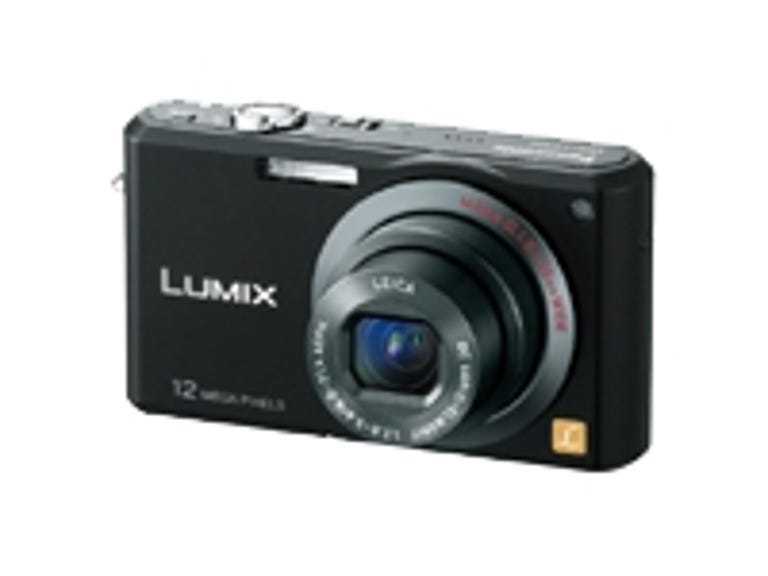 Why You Can Trust CNET
Why You Can Trust CNET Panasonic Lumix DMC-FX100 review: Panasonic Lumix DMC-FX100
Panasonic Lumix DMC-FX100
Casio's Exilim EX-Z75Sony's Cyber-shot DSC-T20Sony's Cyber-shot DMC-W200Casio's Exilim EX-Z1200
The Good
The Bad
The Bottom Line
Panasonic follows the if-it-ain't-broke-don't-fix-it logic by keeping the body design essentially the same as that of their other FX-series cameras. The 3.6x optical, 28mm-to-100mm (equivalent), f/2.8-to-f/5.6 zoom lens extends from the front of the body when you turn the camera on and the zoom control takes the form of a ring around the shutter button with a nub on front that you can operate with your forefinger. The mode dial is built into the upper-right corner of the camera back, putting it out of the way but still convenient to use. Five small buttons, located to the right of the 2.5-inch, 207,000-pixel LCD on the camera back, double as menu controls and quick controls for functions including exposure compensation (plus or minus 2EV in one-third-stop steps), self-timer, flash, and review (in case you don't want to switch to full-on playback mode on the mode dial). Below these buttons are two small, round buttons for display controls and function/trash. The only other hard controls are the on/off slider and E.Zoom button, both on the camera top. This last one brings you to the far end of the optical zoom with the first press, adds digital zoom to bring you to a 7x zoom on the second press, and back to the widest angle on the third press. Of course, if you start at the far end of the zoom, then the first press will bring you to the 7x (with digital) zoom, and so on. Be careful though, since this button will cycle through the digital zoom even if you have it turned off in the menus.
Like a lot of compact cameras, the FX100 doesn't have manual exposure controls, though it does include 20 preset scene modes to help you deal with tough--or just plain unusual--shooting conditions. A pair of features helps you deal with blur. Panasonic's Mega OIS lens-shift stabilization helps combat hand shake, while Intelligent ISO control--a separate shooting mode available on the mode dial--analyzes motion in your subject and automatically raises the ISO to a limit you select in the menu to help prevent blur caused by a fast-moving subject. This can come in handy if you don't want to manually set ISO to boost your shutter speed; the camera will keep the ISO as low as possible if your subject is still, thereby minimizing noise in your images when the lighting is suboptimal. Like past FX models, you can also choose from 4:3, 3:2, or 16:9 aspect ratios in case you prefer to view your images on a TV or a digital photo frame instead of making prints. You can also select 4:3 or 16:9 ratios when capturing movies, though you're limited to 15 frames per second if you opt for 1,280x720-pixel video.
The DMC-FX100 showed good shutter lag times but was otherwise no more than average in our lab-based performance tests. The camera took a slightly sluggish 2.4 seconds to start up and capture its first JPG image. Subsequent JPGs took 2.3 seconds between shots with the flash turned off, slowing a bit further to 2.9 seconds with the flash on. Shutter lag measured 0.6 second in our high-contrast test and 1.1 seconds under low-contrast conditions, which mimic bright and dim shooting conditions, respectfully. At 12 megapixels, the burst mode clocked an average of 1.3 frames per second, but rose to 4.4fps when we lowered the pixel resolution to VGA.
Image quality is generally good, with sharp images, accurate-looking colors, a healthy amount of shadow detail, and consistently accurate white balance and exposures. However, noise remains one of Panasonic's weakest points. Even at the camera's lowest sensitivity setting of ISO 80, I saw noise in our test images. The noise is minimized in prints but is readily noticeable when viewing images at full size on computer monitors. The noise is less obvious on subjects with texture, such as the plush ape in our test scene, but creates a mottled look on dark-colored smooth surfaces, such as the navy-blue toy car in the same scene. Panasonic's noise-reduction algorithms manage to keep noise under control through ISO 200 with only very slight falloffs in sharpness and shadow detail. At ISO 400, noise bumps up, colors start to wash out, and shadow detail begins to decline, but images are definitely still usable. At ISO 800, conditions worsen as both sharpness and shadow detail deteriorate, though you'll likely still be able to get pleasing 4x6-inch prints. At both ISO 1,250 and ISO 1,600, noise becomes very heavy and sharpness and shadow detail take a nose dive. I suggest staying below ISO 800 whenever possible and below ISO 1,250 altogether. That said, Panasonic is doing a much better job at combating noise than it did even a couple of years ago. Given that this is a 12-megapixel compact camera, I was surprised at the results it produced.
Considering the usefulness of the 28mm wide-angle lens, the convenience of the Intelligent ISO mode, and the FX100's impressive white balance and metering, this camera is a good choice if you feel you absolutely must have a 12-megapixel compact camera. However, you probably don't need so many pixels. If you don't plan on cropping heavily or making extremely large prints, you'd be better served going for a camera with a lower megapixel count and better noise results, such as the Canon PowerShot SD850 IS or if you don't mind ultracompacts, Sony's Cyber-shot DSC-T100, both of which cost around the same price as this Panasonic.
(Shorter bars indicate better performance)
(Longer bars indicate better performance)
